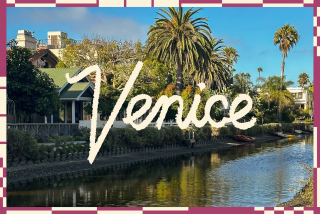Here at the end of the Western World, there’s a market for trinkets and trash
My friend Duke Russell telephoned the other day and asked if I could meet him and Shirley for lunch at the Sidewalk Cafe, in Venice.
I had read the story in the paper about the Lafayette Cafe closing because the rent was being raised, and I was alarmed by what it said about the changes along the boardwalk (it’s really asphalt).
I decided to take a look.
We had lived for a year or two in Venice, on the Grand Canal, not long after the war. At that time Venice was in a state of decay; the canals were dirty and still; the old hotels and houses along Ocean Front Walk were crumbling and moldy. But the village along Windward Avenue still had the Italianate facades from the days when Abbott Kinney had dreamed of re-creating Venice, Italy, by the California sea. The pace was slow, and the place had some charm.
My first shock was good. I drove into the parking lot on the beach at the end of Washington Boulevard and the attendant said, “Are you 62?”
I told him I was, and he said “It’s free then. Have a nice day.”
It was the first thing I had ever got free for being old, except Medicare.
I took it as a sign that we elders had not been excluded from our own seashore.
I walked out to the end of the pier. It was much as it had always been. Fishermen, young and old, men and women, stood or sat patiently by the rails in the light fog, evidently hoping to catch something edible. I doubted that they would. They were of every race--Latino, Asian, black, white--whole families of them.
Boys on skateboards raced along the pier. They would come straight at me, angling off only at the last moment; obviously their game was to make me give way. I am too old to be bluffed by boys on skateboards.
I walked north toward Windward Avenue. Soon the little houses and apartments squeezed up together along Ocean Walk became shops with their wares set out in the open air: T-shirts, sunglasses, tank shirts, sweat shirts, earrings, radios, leather pants ($75).
It became one continuous display of tawdry merchandise, utterly without charm. I remembered how scornful I was of San Francisco when its once picturesque Fisherman’s Wharf was given over to bins of sleazy souvenirs. This seemed worse.
This was the famous West Coast; the end of the continent; the end, actually, of the Western World; and we had let it slide into a cheap bazaar, a penny-grubbing row of hustlers.
At Windward I looked up the street and saw that there were still four of Kinney’s fake Italian palazzos, with their arches and columns and ornate capitals. One of them had been painted pink, blue, yellow and green.
On the beach at Windward stood two indescribably ugly concrete monoliths. I don’t know what the northernmost one was. It appeared to be a compound for the storage of equipment. The other one, I believe, had been built in the 1960s as a social center, with recreation rooms and a patio filled with thick concrete tables for picnicking. Inside the patio one man was sleeping on a table. Two others were cooking at one of the enormous barbecues. They looked as if they lived there.
Nothing seemed to be doing in the rest of the building. It evidently had been built, probably at a cost of millions, with the idea that people would like to go to the beach and shut themselves up inside a concrete dungeon to have fun, protected from the sea breezes and the view.
It was nothing now but a massive, gray, graffiti-covered blob; a great white elephant testifying to the stupidity of some administration. All it did was block off a great stretch of that matchless panorama, the Pacific Ocean, and destroy a great patch of beach.
How did such an eyesore happen?
Duke and Shirley had dressed for protective coloration, Duke in a red-orange Hawaiian shirt and a straw hat and shorts; Shirley in a white jump suit with broad blue stripes on top and a blue visor.
“Everybody does his thing here,” Duke said.
He was right. The people were wonderful. Along the boardwalk there was a continuous parade of people doing their thing. People in gaudy T-shirts, tank shirts and no shirts; people riding skateboards, feeding on pizzas and hot dogs and slurping sodas; girls in skimpy bikinis going in sexy phalanxes; loners lost in the sound of their earphones; iron-pumpers showing off their muscles; and cops--a sight to see--on bicycles.
In the Sidewalk Cafe a young man on roller skates showed us to a table and we ordered from a surprisingly literary menu that had omelets named for Emily Dickinson, William Faulkner, Walt Whitman, Robert Frost, Gertrude Stein and Jane Austen, among others. I had the Andy Warhol Chinese chicken salad and a glass of white Bordeaux.
Evidently the literary flavor of the menu was inspired by the bookstore that adjoins the cafe.
Our lunch was pleasant; the cafe is an ornament, like some of those on the Grand Canal in Venice, Italy. But I’m afraid that in a year of so it will give way to three stores selling trash and trinkets.
I suppose people get the kind of atmosphere they deserve. Maybe most of those people on the boardwalk are happy with the marketplace that Venice has become.
Perhaps it’s only fitting that the West Coast of the world’s most materialistic nation should be a storefront.
More to Read
Sign up for The Wild
We’ll help you find the best places to hike, bike and run, as well as the perfect silent spots for meditation and yoga.
You may occasionally receive promotional content from the Los Angeles Times.






